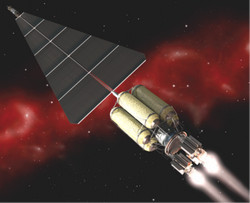Nuclear technology for deep-space exploration
Electric thrusters use electromagnetic radiation to heat up and ionise gas such as xenon or hydrogen. A magnetic nozzle directs the produced superheated plasma out the back, creating thrust. A nuclear electric spacecraft, with a nuclear core producing ~5-10MW of power, would be able to deliver either heavy cargo or astronauts to Mars orbit and back in a relatively short time and in a flexible way (trajectory wise). Serious work on the concept of nuclear-powered spacecraft began in France and the United Kingdom in the 1980s. But, the former Soviet Union had launched multiple fission reactors between 1965 and 1987. The MEGAHIT (Megawatt Highly Efficient Technologies for Space Power and Propulsion Systems for Long-duration Exploration Missions) project had, therefore, as its second objective to create a European community including Russia to power a manned Mars mission and sample return from giant planets. Building a roadmap for the development of such in-space propulsion systems was the first objective of the project MEGAHIT. A nuclear reactor as a power source is not a new concept in space, but Europe has not flown a nuclear-powered spacecraft to date. The consortium formalised a technology plan for the development of such a nuclear-powered spacecraft. Together with the roadmap for low- and medium-power systems prepared within the project DIPOP(opens in new window), MEGAHIT's International Nuclear Power and Propulsion System (INPPS) roadmap offers a pathway to advance Europe's current capabilities. Potential collaboration opportunities with space-faring nations were explored. It is a long-range technology development activity, but part of Europe's mission architecture for deep-space exploration is to use nuclear powered spacecraft. Follow-on projects from the MEGAHIT project are expected to generate specific initiatives in robotic exploration of our solar system and human spaceflight. The EU H2020 project DEMOCRITOS(opens in new window) is following up on several of the highlighted technology demonstrators of the MEGAHIT INPPS technology roadmap.




